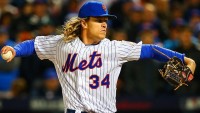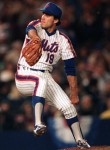Sid Fernandez
Lost in all the offensive struggles is the fact that this Mets team is built upon pitching. As a franchise, the Mets always have and always will be built upon pitching. It started with Tom Seaver, Jerry Koosman, and Jon Matlack in the late 60’s. It was continued in the 80’s with Dwight Gooden, Ron Darling, Sid Fernandez, and David Cone. The mantle was supposed to be picked up this year by the Mets young rotation.
However, the rotation has had some struggles. Matt Harvey struggled mightily going 2-4 in May with a 5.91 ERA. To a lesser extent, Jacob deGrom struggled in May going 0-1 with a 3.86 ERA. The concern with deGrom was not so much the results but the seemingly precipitous drop in velocity. These were to the two aces the Mets road all last year and into the postseason. These were supposed to be the two aces this year leading the team while the younger starters developed. Instead, the reverse has been true.
Noah Syndergaard has taken the next step this year. He is 5-2 with a 1.84 ERA and a 0.958 WHIP. He is throwing fastballs up and over 100 MPH, and more impressively, he is throwing sliders around 95 MPH. He is as dominant a pitcher as there is in baseball right now.
Steven Matz was named the National League Rookie of the Month for the Month of May. It was a well deserved honor after going 4-0 with a 1.83 ERA and a 0.757 WHIP. In fact, if you take away his first nightmare of a start, a start he made after a long period of inactivity, Matz is 7-0 with a 1.51 ERA and a 0.932 WHIP. Matz has been the pitcher everyone has imagined he would be and more since he burst onto the scene last year beating the Reds from the mound at the plate.
Overall, Syndergaard and Matz have taken the next step. On almost any other rotation, they would be the unquestioned ace. That was the same thing that has been said for Harvey and deGrom. On that front, there is some great news as well. In Harvey’s last start, he went seven innings allowing only two hits, no runs, and one walk with striking out six. In deGrom’s last start, he went seven innings allowing five hits, one run, and two walks while striking out 10. More importantly, deGrom’s velocity is returning with him getting his fastball up to 96 MPH.
So yes, it appears like the 2016 Mets are continuing the franchise’s legacy of having great pitching. With Syndergaard and Matz being ahead of schedule in their development coupled with Harvey and deGrom starting to return to last year’s form, the Mets rotation is stacked with four aces. If you’re a baseball player or a poker player, you know four aces is next to impossible to beat no matter whatever else you have in your hand . . . even if that hand contains the deuce that the Mets offense was over the month of May.

Going into the 2016 season, there is one fear each and every Mets fan has. We dare not speak its name, but that doesn’t change the fact that it’s still present. That fear is that a pitcher will get seriously injured.
Looking at this year’s list of pitchers who could befall the dreaded “Verducci Effect,” Noah Syndergaard headlines that list. If Syndergaard was to suffer a season ending injury requiring Tommy John surgery? it would greatly hinder the Mets chances of winning not only the World Series, but also making it to the postseason. It’s something that not just Mets fans fear, but as Anthony DiComo of MLB.com reports, Syndergaard fears it also:
I’ve thought about it quite a bit. But I trust myself to put my body in the right situations to be able to perform at a healthy level.
The fear is justified. Syndergaard threw 65.2 innings more last year. He throws over 95 MPH more than anyone in the game. He’s working to add the fabled Warthen Slider to his already dominant repertoire. Name a risk factor for UCL years requiring Tommy John surgery. Syndergaard meets most if not all of them.
One risk factor not readily discussed is the team he plays for. Look at the projected Mets rotation when healthy: Matt Harvey, Jacob deGrom, Noah Syndergaard, Steven Matz, and Zack Wheeler. Put aside Syndergaard for a moment. What do the other four have in common? They are all hard throwing pitchers under the age of 30 who have already had Tommy John surgery.
Go outside this group. Since Warthen took over as the Mets pitching coach, the following homegrown Mets have sustained arm injuries: Jon Niese (shoulder), Dillon Gee (shoulder), Jeremy Hefner (two Tommy John surgeries), Rafael Montero (shoulder), Bobby Parnell (Tommy John), Josh Edgin (Tommy John), Jack Leathersich (Tommy John). There are more, but you get the point.
Now, is this an organizational problem since Warthen took over, or is it just bad luck? Could this all have been avoided? Back in the 60’s and 70’s the Mets developed pitchers like Tom Seaver, Jerry Koosman, Nolan Ryan, and Jon Matlack. These pitchers threw more innings than the pitchers today, and yet, Matlack was the only one of this group that suffered an arm injury.
In the 80’s, the Mets had Dwight Gooden, Ron Darling, Sid Fernandez, Rick Aguilera, Randy Myers and David Cone. Of this group, only Doc and Cone had arm issues. It should be noted that Doc had many other issues as well, and Cone’s problem was an aneurysm later in his career.
In the 90’s, Generation K was a bust, and the Mets haven’t developed the caliber of starting pitchers like they have in the past until now. However, this generation seems to befall injuries far more often than their predecessors. Is it organizational? Is it bad luck? Is it preparation? For his part, Harvey wonders what if:
I think now, there are things I could have done better in high school or in college to maybe prevent it. But I don’t know. I’m not saying [Syndergaard] works that much harder than everybody else, because we all work hard. I think as time progresses, guys pay more attention to stretching the shoulder, strengthening the shoulder. If I could go back — I don’t know if this would’ve prevented me from having [surgery], but if I could go back and really do 20 extra minutes of stretching and arm care, you never know what could happen.
That’s the thing. We really don’t know why one guy suffers elbow and shoulder injuries while others don’t. Is it preparation? Is it good genes? Is it just good luck? Much time, energy, and money has been spent on this issue, and yet pitchers still get injured. Pitchers get injured despite teams doing everything in their power to try to prevent it.
It will help Syndergaard being in a clubhouse with players who have had Tommy John surgery. They each will have advice for him on why they suffered the injury and what they could’ve done differently. More importantly, Syndergaard appears to be a hard worker who takes the health of his arm very seriously. There is no doubt he is doing everything he can do to avoid the dreaded Tommy John surgery.
Based on what we’ve seen, if anyone can avoid it, it’s him.
Editor’s Note: this article was first published on metsmerizedonline.com

You never know what is going to happen before or during a postseason series. How a team responds to it may determine if a team wins or loses a series.
I was reminded of that with another playoff series against the Dodgers. Both times the Mets played the Dodgers, one of their starting pitchers was injured.
In 1988, Bobby Ojeda suffered a potentially career ending injury on the same day the Mets clinched at least a tie atop the NL East. It threw the Mets postseason rotation off kilter. Dwight Gooden started Games 1 and 4 (on three day’s rest). He wouldn’t make another start in the series.
I still don’t know what Davey Johnson was thinking. The Mets had a 2-1 series lead. They already won a game in which Orel Hershiser started. Johnson unnecessarily went to Gooden on three days rest, and then he left him in too long. Even more baffling is the fact that Johnson went to Sid Fernandez in Game 5 with the series tied 2-2.
Honestly, I don’t think Johnson doesn’t make a ponderous decision like this if Ojeda was able to pitch. Ojeda was 2-0 in the 1986 postseason. He stabilized things in Game 3, and he gave the Mets a chance in Game 6. Johnson doesn’t skip his start in 1988, and the Mets probably don’t blow that series.
Eighteen years later, the Mets again found themselves facing the Dodgers in the playoffs. Again, a key starting pitcher went down. Two days before the NLDS, El Duque, the scheduled Game 1 starter, went down with a torn calf muscle. Keep in mind, he was the second choice after Pedro Martinez suffered a rotator cuff injury.
Willie Randolph gave the ball to John Maine. Maine lasted 4.1 innings before hitting trouble. Randolph quickly turned to his incredible bullpen who brought it home. The Mets responded better to the problem in 2006, and they won the series.
It’s possible the Mets have already been presented with their Ojeda-El Duque dilemma with Steven Matz. Matz slept on a sofa, and he injured his back. The Mets now have a critical decision to make, especially with Matz having a successful simulated game. If he responds well, he may be on the roster. If not, it will be Sean Gilmartin.
Whomever the Mets choose, history shows it’s not who you pick that’s important. It’s how you respond to the crisis that’s important. Fortunately, this is one of Terry Collins’ strengths. Hopefully, there won’t be any more surprises.
Lets Go Mets!